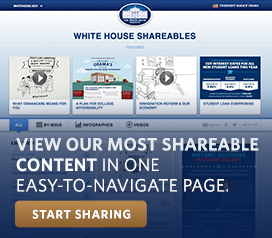Catalyze Breakthroughs for National Priorities
Innovations Home | Building Blocks | Enterpreneurship | Breakthroughs
There are certain sectors of exceptional national importance where the market is unlikely to produce the desirable outcomes on its own. These include developing alternative energy sources, reducing costs and improving lives with health IT, and manufacturing advanced vehicles. In these industries where markets may fail on their own, government can be part of the solution. Below are examples of Obama Administration initiatives that are catalyzing breakthroughs for national priorities.
Unleash a Clean Energy Revolution
- Advanced Research Projects Agency – Energy (ARPA-E)
The Advanced Research Projects Agency – Energy (ARPA-E) received $400 million in funding through the American Recovery and Reinvestment Act (ARRA). ARPA-E’s mission is to fund projects that will develop transformational technologies that reduce America’s dependence on foreign energy imports; reduce U.S. energy related emissions (including greenhouse gasses); improve energy efficiency across all sectors of the U.S. economy and ensure that the U.S. maintains its leadership in developing and deploying advanced energy technologies.
Learn more.
Support Advanced Vehicle Technologies
- Next Generation Batteries and Electric Vehicles
48 new advanced battery and electric drive projects received $2.4 billion in funding under the American Recovery and Reinvestment Act. These projects, selected through a highly competitive process by the Department of Energy, will accelerate the development of U.S. manufacturing capacity for batteries and electric drive components as well as the deployment of electric drive vehicles, helping to establish American leadership in creating the next generation of advanced vehicles.
Learn more.
Drive Innovations in Health Care Technology
- NHIN Direct
The Nationwide Health Information Network (NHIN) is a set of standards, services and policies that enable secure health information exchange over the Internet. NHIN Direct is a project to expand the standards and service definitions that, with a policy framework, constitute the NHIN. Those standards and services will allow organizations to deliver simple, direct, secure and scalable transport of health information over the Internet between known participants in support of Stage 1 meaningful use.
Learn more.
- Health IT
15 communities received $220 million in funding under the American Recovery and Reinvestment Act to serve as pilot community for wide-scale use of health information technology (health IT) through the Beacon Community Program. Health IT allows comprehensive management of medical information and its secure exchange between health care consumers and providers. Broad use of HIT has the potential to improve health care quality, prevent medical errors, increase the efficiency of care provision and reduce unnecessary health care costs, increase administrative efficiencies, decrease paperwork, expand access to affordable care, and improve population health.
Learn more.
Watch the announcement by Vice President Biden and Health and Human Services Secretary Sebelius.
- SHARP Awards
The SHARP Program funds research focused on achieving breakthrough advances to address well-documented problems that have impeded adoption of health IT and accelerating progress towards achieving nationwide meaningful use of health IT in support of a high-performing, continuously-learning health care system.
Learn more.
Harness Science and Technology to Address the “Grand Challenges” of the 21st Century
- AIDS Research and Prevention
In FY2010, the Obama Administration’s PEPFAR (President’s Emergency Plan for AIDS Relief, originally launched by President George W. Bush) expanded existing investments in prevention of mother-to-child HIV transmission programs with additional bilateral HIV/AIDS funding, building upon successes in women and children’s health. This investment will focus on prevention of mother-to-child transmission and improving integration of HIV/AIDS programs with other primary and specialty care for maternal and child health.In October 2009, President Obama signed the Ryan White HIV/AIDS Treatment Extension Act of 2009 which reauthorized the Ryan White Program for four years. The Ryan White HIV/AIDS Program, under HHS's Health Resources and Services Administration, works with cities, states, and community- based organizations to address the unmet care and treatment needs of over half a million persons living with HIV/AIDS.
Learn more.
- NIAID (National Institute of Allergy and Infectious Diseases)
In September NIAID announced the development of a vaccine that provides partial protection from HIV infection, and NIAID is shifting resources to increase support of innovative basic research that will help answer fundamental questions needed to guide the development of future HIV vaccine candidates.
Learn more.


